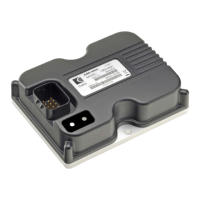28
Curtis 1352 eXm Manual, R ev. D
Output Driver Mode
The eXm allows four distinct output control modes:
Input Only: The driver output is disabled. This mode is used when the
output is used as an input.
Constant Current: The eXm continually samples the output load current
and automatically adjusts the output PWM (500 times per second) to
maintain the commanded current. The load current will stay constant
over varying battery voltage, load resistance variation, and temperature.
Current mode allows Dither, which puts a small variation on the current
command. Dither is used to keep proportional valves accurate and moving
freely. The frequency and the amount of dither can be adjusted.
Constant Voltage: The eXm continually samples the battery voltage and
automatically adjusts the output PWM to maintain an average output
voltage to the load. The load voltage is constant over varying battery voltage,
as long as there is enough voltage to supply the commanded output.
Direct PWM: The eXm simply outputs the commanded PWM.
The active modes (Constant Current, Constant Voltage and Direct PWM) can
also have an additional system check enabled called Open Detect. To enable this
function, add 4 to the active mode setting (i.e., Constant Current Mode = 1;
Constant Current Mode with Open Detect = 1+ 4 = 5). Open Detect checks that
the driver output pin is connected to a load whenever the command is zero. When
there is no PWM, the output pin is basically connected to B+ through the load.
If the load opens (wire is disconnected or load fails), the Open Detect will signal a
fault (Driver Open Fault) and shut down that driver until the load is reconnected.
PI Controller
Constant Current and Constant Voltage Modes use a Proportional/Integral (PI)
closed-loop controller. These controllers work to minimize the error between the
command and the actual output. To do this, the error is magnified by the Driver
Proportional and Integral Gains. Normally, the factory settings of these gains is
sufficient to control the load. However, there may be times when they need to
be adjusted to increase or decrease the responsiveness of the eXm.
If you find that the eXm over-reacts to changes in battery or load, lower
these gains. If it is too slow to react, increase them. If the gains are set too high,
the output may oscillate. Normally, the Proportional and Integral gains are in-
creased or decreased together. It is not recommended to have one gain very high
while the other is very low.
Changing Modes
Because each Driver Mode has its own scaling (amps, volts, or %), changing the
mode also automatically changes the range of the Output Max Value parameter.
For safety, whenever the Driver Mode parameter is written to, the Output Max
Value parameter is set to minimum and the present command (as set by the
PDO-RX (MOSI) is set to 0. This is done because the eXm has no idea what
the desired output should be after a mode change, and the last setting of the
5 — SDO: Device Parameter Objects

